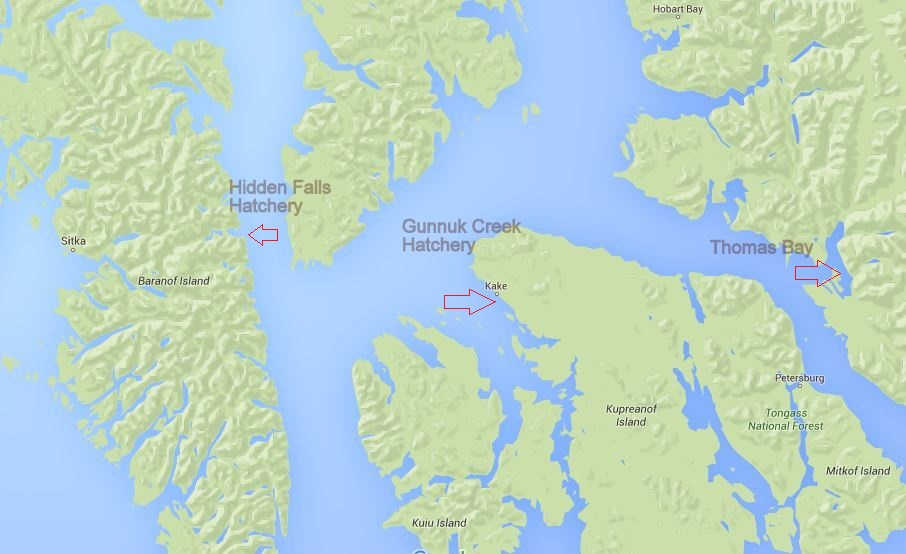
NSRAA’s Steve Reifenstuhl says Gunnuk Creek’s location, mid-way between Hidden Falls and Thomas Bay, makes it the ideal location to rear eggs for Thomas Bay.
A controversial plan to release millions of chum salmon in a popular sport fishing area near Petersburg has been put on hold, while the state gathers more information about the proposal.
The six-member Northern Regional Planning Team voted unanimously (on 12-3-15) to table a request from the Northern Southeast Regional Aquaculture Association to develop a remote release site for chum fry in Thomas Bay, about 12 miles north of Petersburg. Two other permit requests from NSRAA, however, won the team’s approval.
Note: State aquaculture permits are issued for the quantities of eggs reared — not the number of actual fry to be released. NSRAA has asked for a permit to rear up to 60-million eggs for Thomas Bay, Port Malmesbury, and Gunnuk Creek. The number of fry — and consequently adult returns — would be substantially less.
After years of producing record chum salmon runs, the Hidden Falls Hatchery is hurting. Low returns are forcing the Sitka-based Northern Southeast Regional Aquaculture Association — or NSRAA — to look elsewhere to release some Hidden Falls stock, in the hope of improving the chances that the young fish will survive to become adults.
NSRAA has asked the state to allow it to release chum fry in Thomas Bay, which is just a short run up Frederick Sound from Petersburg.
Sam Rabung is in charge of aquaculture for the Commercial Fisheries division of the Alaska Department of Fish & Game. It’s his job to pass along any recommendations of the regional planning team to the Commissioner.
“Well one of the things we’re concerned about is the potential for user conflicts. We have existing fisheries and existing users in the Thomas Bay area that have concerns about this. So we wanted to get a handle on how this may or may not impact them, before we move forward.”
Although consensus in the meeting room, among the Petersburg Vessel Owners Association, which represents mostly the seine fleet, and the other commercial interests present, was to allow NSRAA to proceed with a limited release of only 6-million fry, there was vocal opposition over the phone from Petersburg sport fishermen and hand trollers, who argued that the returning chum — up to 150,000 fish possibly — might interfere with the harvest of king salmon in the area.
Rabung thought it was important to determine how many kings might be feeding in Thomas Bay.
“We don’t really know what’s in there in July — what may be harvested in a seine fishery. So we want to take a look before we embark on something like this that could have consequences.”
Rabung said that he would be willing to issue NSRAA a research permit to do some test fishing. The regional planning team then decided to table the Thomas Bay request. NSRAA General Manager Steve Reifenstuhl thought it was “a reasonable action…”
“To go through a little more public process and go through use at Thomas Bay, as well as the potential for feeder kings in the area through a test-fishery program, and get a little more information and bring it back next year and see if that calms people’s concerns.”
But NSRAA did not come away from the meeting empty-handed. With negligible user conflict or by-catch concerns, the regional planning team voted unanimously to recommend a permit for NSRAA to release chum at Port Malmesbury, which lies due east across Chatham Strait from Port Alexander, and at the defunct Gunnuk Creek Hatchery in Kake.
Reifenstuhl says that if things turn around at NSRAA’s primary hatchery at Hidden Falls, and at the Takatz Lake rearing site, it may not be necessary to release fish at Port Malmesbury.
But Gunnuk Creek in Kake is part of a larger design to expand NSRAA’s chum operation toward Petersburg.
“Gunnuk Creek is roughly halfway between Hidden Falls and Thomas Bay. We’ve been trying to get a big chum salmon program close to Petersburg. Gunnuk Creek will be part of that. Thomas Bay would be a great remote release site operated out of Gunnuk Creek, once we operate that.”
Gunnuk Creek was built in the late 90s by the Kake Nonprofit Fisheries Corporation, but has since gone into bankruptcy, with over $20-million in debt. The US Department of Commerce foreclosed on the facility, and plans to sell it at auction early next year.
Reifenstuhl says he thinks it “highly unlikely” that any organization other than NSRAA will bid on the purchase, or sink an estimated $2.5-million into refurbishing it. The outcome of the sale, though, will affect how NSRAA moves forward.
“If we don’t own the facility,” Reifenstuhl said, “we won’t put fish there.”































